
Colorado National Monument

Looking in from the west entrance, near Fruita

Colorado National Monument is a place that I hadn't been to in at least 40 years. I have memories from my childhood but they really didn't measure up to the spectacular place I drove into in September, 2007. What I found far exceeded my memories (and my expectations) and, hopefully, will bring me back again in 2008 when I 'm working towards having some time to explore more backcountry properly.
Colorado National Monument and McInnis Canyons National Conservation Area share a 225 square mile, red-rock plateau that, in most places, rises more than 2,000 feet above the Grand Valley. The area is full of rugged canyons that drain into the Colorado River. The plateau, mesas and ridges are covered with piñon and juniper woodlands interspersed with sagebrush flats. My visit was too short to allow me to go into McInnis Canyons NCA the way I'd like to but next year...
I drove in through the West Entrance, near Fruita, Colorado. I spent most of my time driving Rim Rock Drive but I did get out and hike some of the short trails and saw some incredible countryside. There were quite a few overlooks along the way, most of them with wayside exhibits and interpretive signage. Rim Rock Drive is paved all the way but it really hugs the canyon rim, you'll need at least an hour to drive the 23 miles to the East Entance. You'll also want more time so you can stop, hike a bit, get some photos, and just plain enjoy the incredible views. If you have a height problem, most of the overlooks have fences or guard rails to help you maintain your equilibrium while enjoying the scenery. And while you're at it, stop at the Visitor Center and explore what's inside: they've done a great job of explaining what you are looking at and why it's here.

Looking up in Fruita Canyon
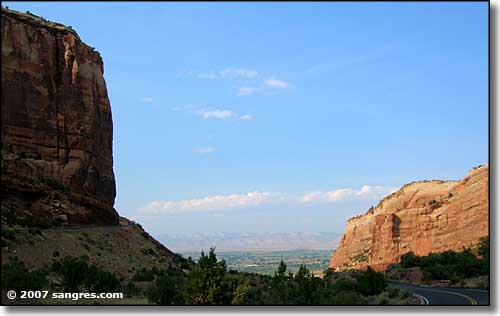
Looking north in Fruita Canyon
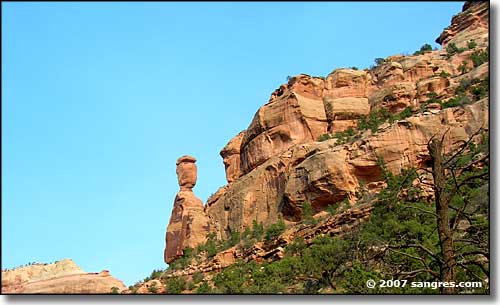
Balanced Rock in Fruita Canyon

Colorado National Monument Visitor Center
There are three picnic areas in the park: next to the Visitor Center, near the Saddlehorn Campground and near the East Entrance at the Devils Kitchen picnic area. The Devils Kitchen and Visitor Center picnic areas are both handicap accessible and offer shade shelters. The Saddlehorn and Devils Kitchen picnic areas both have charcoal grills, tables, water, and restrooms. There are accessible restrooms at the Visitor Center, Saddlehorn Campground and Devils Kitchen picnic areas.
Saddlehorn Campground has 80-sites open year round, some are even pull-through and two are handicap accessible. There is a self-registration kiosk at the campground entrance and sites are available first-come, first-served. The campground offers flush toilets and water, and picnic table, charcoal-only grill and parking area for each site. There are no electric hookups or showers and wood fires are not permitted anywhere in the park. Camping fees are $10 per night and are in addition to the entrance fees. Each site is allowed 2 cars, 3 tents and 7 persons per site. To camp in the backcountry, get a required, free permit at either entrance station or at the visitor center and be prepared to carry lots of water for your stay (water you find in the backcountry may carry Giardia or even be polluted with selenium, a naturally occuring heavy metal that water leaches out of the soil).
Leashed pets are allowed in the campground and along the roadway but not in the backcountry or on any trail. If you wish to use recreational horses or other pack animals in the Monument, contact the Visitor Center for details. As most of this area is designated wilderness, off-road vehicles are not allowed and off-road biking is strictly limited to Rim Rock Drive and a couple of other connecting roads.
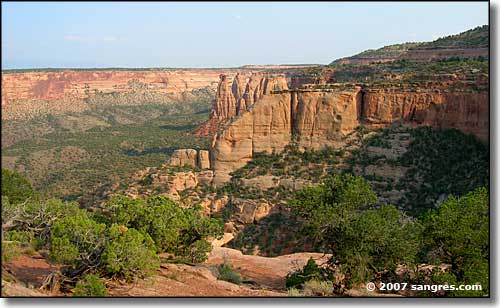
Looking east into Monument Canyon
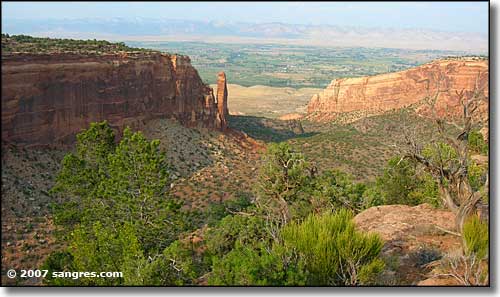
Wedding Canyon
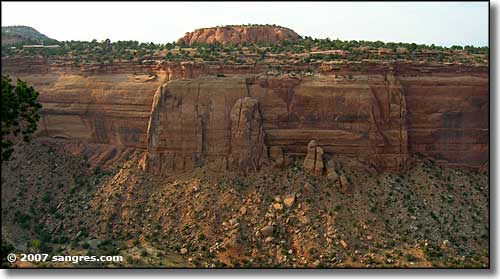
Looking back towards the Visitor Center
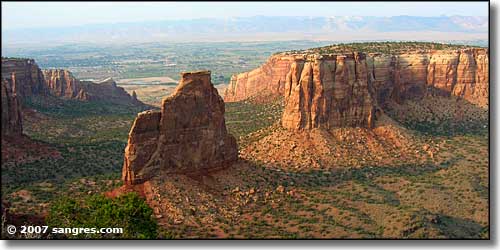
Independence Monument, in Monument Canyon
In Colorado National Monument, the rock layers you are driving among and looking at are up to 2 billion years old - nearly half the age of planet Earth. The layers of rock were deposited over millenia and then carved by the extraordinary forces of erosion carried out over even more time. When John Otto first came across this countryside in 1906, he resolved to lobby Congress to do something to preserve this incredible place. In 1911, after innumerable letters, petitions and requests from the citizens of Grand Junction and other surrounding areas, President William H. Taft used the 1906 Antiquities Act to create Colorado National Monument. John Otto volunteered his services at $1.00 per month and became the park's caretaker until 1927. Many of the trails in use today were created by him, and many of the monuments still bear the names he gave them back then. Otto was so entranced by this landscape that he even got married in Wedding Canyon, although his bride later said that she just couldn't live with a man for whom even the simplest of log cabins was too much of a barrier to place between himself and the world-at-large. In the 1930's, the men of the Civilian Conservation Corps worked with other agencies and many skilled local workers to carve Rim Rock Drive out of the plateau's sandstone, using mostly hand tools and wheelbarrows in their labors.

Looking west into Monument Canyon

The Coke Ovens
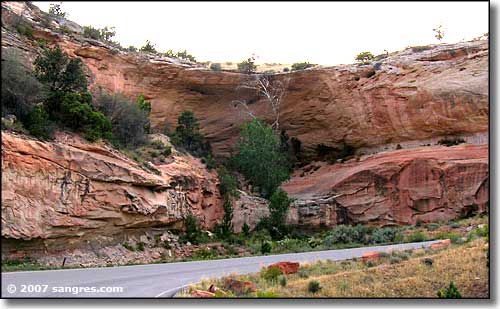
Looking up near the upper trailhead of Serpents Trail
Because of the wide variation in terrain and elevation, the weather and climate here are quite varied. Desert, semi-desert and upland climates are represented with the elevations ranging from 4,000 feet to over 7,000 feet above sea level.
Spring temperatures are usually mild with daytime highs in the mid 60's. In the summer months, the daytime highs run in the 80's and 90's, although down in the canyons the temperatures can easily reach and exceed 100 degrees. Winters tend to be mild with highs between 20 and 45 degrees while the nighttime lows can drop to zero.
Annual precipitation averages 11 inches, the wettest period being August through October with other wet spikes in March and May.
